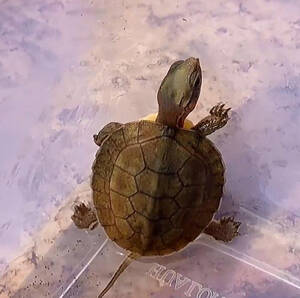Cuora pani
IUCN
LCBasic Information
Scientific classification
- name:Cuora pani
- Scientific Name:Cuora pani,Pan's box turtle,Pan's box turtle
- Outline:Testudines
- Family:Testudinidae B.turtle
Vital signs
- length:13-15cm
- Weight:300-700g
- lifetime:50-80years
Feature
At around 15℃, they stop eating or eat less, and below 10℃, they enter hibernation
Distribution and Habitat
Pan's box turtle is endemic to China and is distributed in Pingli, Shaanxi, Guangyuan County, Sichuan, southern Yunnan, and Xinyang, Henan.
Appearance
The body is small, with a carapace length of 115-120 mm, a width of 81-86 mm, and a shell height of 37-40 mm.
The head is relatively narrow and long, with a length of 32-33 mm, a width of 18 mm, and a height of 16 mm. The skin on the back of the head is smooth. The snout is long and protrudes from the upper jaw, which is slightly hooked; the nostrils open at the tip of the snout. The orbit is large, with a diameter of 8-8.5 mm × 7.5 mm, which is about the same length as the snout, and the tympanum is obvious.
The carapace is relatively low and flat, long and oval, with rounded front and rear edges. There are ridges, but no lateral ridges; the cervical shield is narrow and long, in the shape of a long strip or inverted bell; there are 5 vertebral shields, all of which are wider than long. The first vertebral shield is pentagonal, with a protruding front edge in the center, and the rest are hexagonal. There are 4 pairs of rib shields and 12 pairs of marginal shields, all with conce
Details
Pan's box turtle is called Pan's box turtle in foreign language, and has no subspecies.

Pan's box turtle is the northernmost species of the genus Pan's box turtle in China. It was first discovered in 1981 in a ditch beside a rice field at an altitude of 420 meters in Xujiaba, Pingli County, Shaanxi Province. In 1984, Song Mingtao named it Pan's box turtle in memory of Professor Pan Zhongguo, the former director of Shaanxi Institute of Zoology.
American C.H. Ernst and W.P. McCord (1987) published Cuora chriskarannarum based on specimens collected in Jinping County and Ta Lau Mountain (23°30′N, 102°25′E) in southern Yunnan based on animal trade. Zhao Ermi (1989) pointed out that the latter should be a synonym of Pan's box turtle. Therefore, the distribution of Pan's box turtle in China is only known to have a suspicious record in Pingli, Shaanxi and southern Yunnan, and it is discontinuously distributed, with a latitude of 10° between the two places. This turtle is rare in number. Although it has been heard that some specimens have been collected later, there is no official report of the exact origin, so the record of its distribution range has not been expanded. The distribution relationship between Pan's box turtle and other species of the genus Pan's box turtle is a mystery, and the large distribution gap of Pan's box turtle itself is even more of a mystery. Both are topics worthy of in-depth discussion. In 2000, Li Dong and others successively found three in Guangyuan County, Sichuan. Around 2009, six wild Pan's box turtles were found in Xinyang, Henan Province.
Pan's box turtle is an aquatic turtle that lives in mountain streams, rock cracks and rivers with gentle currents and clear water in Ding Hilly Area. It is a carnivorous turtle that feeds on insects, small fish, shrimps, earthworms, livestock and poultry viscera, etc. under artificial breeding conditions. It can eat normally at a temperature of 20℃, and the most suitable temperature is 22-30℃. It stops eating or eats less at around 15℃, and enters hibernation below 10℃. The hibernation period is from November to early April of the following year. The hibernation period in southern China is shorter, generally from December to February of the following year.
The egg-laying period of Pan's box turtle is from July to August every year. The eggs are oval, and 1-9 eggs are laid each time, and they can be laid in batches. The egg weighs 10-20 grams, the average long diameter of the egg is 35-45 mm, and the average short diameter of the egg is 18-25 mm.
Listed in the "Red List of Endangered Species of the World Conservation Union" (IUCN 2000 ver 3.1) - Critically Endangered (CR).
Listed in Appendix II of the Convention on International Trade in Endangered Species of Wild Fauna and Flora (CITES).
Listed in the China Red List of Biodiversity - Vertebrate Volume (Reptiles) - Critically Endangered (CR).
Listed in the List of Terrestrial Wildlife with Important Economic and Scientific Research Values under State Protection issued by the State Forestry Administration of China on August 1, 2000.
Listed in the China Red List of Endangered Animals - Amphibians and Reptiles - Critically Endangered (CR).
Listed in the "National Key Protected Wildlife in China" - Level II.
Listed in the "Mainly Protected Wildlife in Shaanxi Province".
Protect wildlife and eliminate game.
Maintaining ecological balance is everyone's responsibility!








